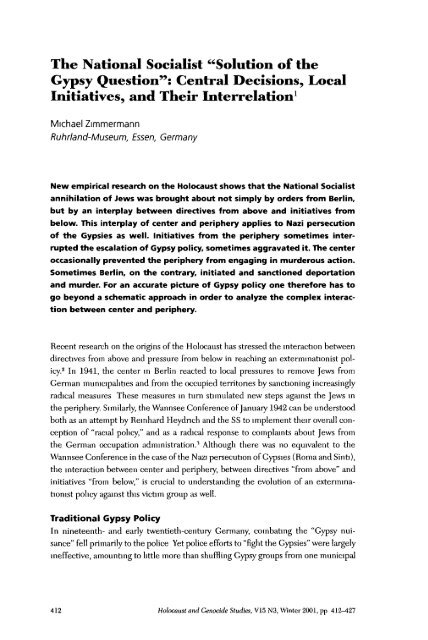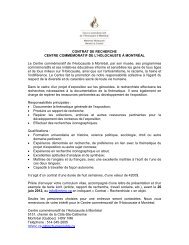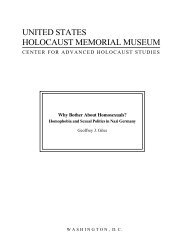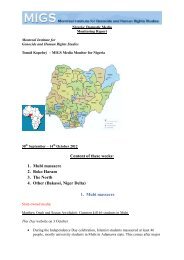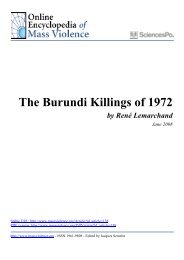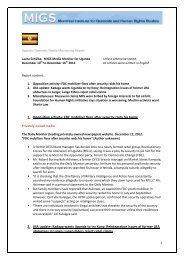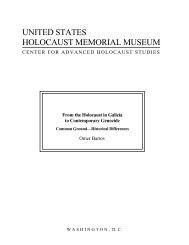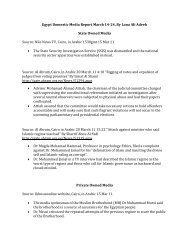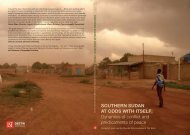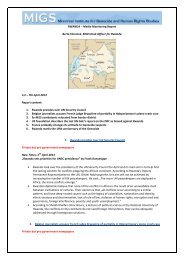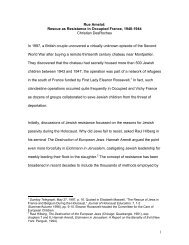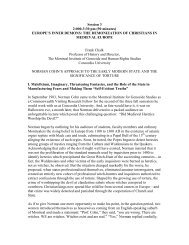Michael Zimmermann - Montreal Institute of Genocide and Human ...
Michael Zimmermann - Montreal Institute of Genocide and Human ...
Michael Zimmermann - Montreal Institute of Genocide and Human ...
Create successful ePaper yourself
Turn your PDF publications into a flip-book with our unique Google optimized e-Paper software.
domain to another The stated objective <strong>of</strong> the measures directed against the Gypsies<br />
on the local level, the aim <strong>of</strong> which was, after all, to prevent them from setding permanently,<br />
was, paradoxically enough, "settling <strong>of</strong> the Gypsies" (Sefihaftvuichung). This<br />
formula was based on governmental attempts to force the Gypsies to settle permanently<br />
<strong>and</strong>, in the words <strong>of</strong> the Enlightenment writer Heinrich Grellmann, to "transform<br />
them into useful citizens " 4 However, since virtually ever)' municipality took it<br />
as self-evident that it would not be the place where Gypsies were to settle, "setding"<br />
could be seen as, in essence, a policy <strong>of</strong> expulsion. It was thus only an apparent contradiction<br />
when, in response to a 1929 survey by the German Municipal Congress<br />
(DeiitscherGemeindetag) on Gypsy policy, the town leaders in Miihlhausen, Thuringia,<br />
indicated that they had not taken any measures to settle Gypsies in their city, but to the<br />
question <strong>of</strong> what legal measures they suggested for die "solution <strong>of</strong> the Gypsy question,"<br />
die same town leaders insisted that the "settling <strong>of</strong> the Gypsies" be "sped up." 5<br />
National-level <strong>of</strong>ficials were well aware <strong>of</strong> die difficulties <strong>of</strong> implementing<br />
Gypsy policies A vaguely worded directive by die Reich Ministry <strong>of</strong> die Interior in<br />
1936 dem<strong>and</strong>ed that die German Gypsies be settled "in a particular place," though<br />
it failed to specify where. 6 When it came to Gypsy policy, die ministerial bureaucracy<br />
was no further along after three years <strong>of</strong> Nazi rule dian its predecessors in the Empire<br />
<strong>and</strong> the Weimar Republic had been<br />
Local Gypsy Camps <strong>and</strong> the "Prevention <strong>of</strong> Crime"<br />
After 1933 the police <strong>and</strong> ministerial bureaucracy <strong>of</strong> die Third Reich maintained a<br />
Gypsy policy that alternated between die goals <strong>of</strong> "expulsion" <strong>and</strong> "settlement." Yet<br />
the discrimination <strong>and</strong> oppression against Gypsies diat characterized the first years<br />
<strong>of</strong> National Socialist rule were not a simple matter <strong>of</strong> traditional Gypsy policy 7<br />
In the L<strong>and</strong>er (states), for example, laws <strong>and</strong> regulations against Gypsies were<br />
<strong>of</strong>ten made more severe Some municipalities <strong>and</strong> lower police authorities used traditional<br />
mediods to control Gypsy groups, including high rents, subst<strong>and</strong>ard living conditions,<br />
sudden foreclosures or even destruction <strong>of</strong> camping areas, <strong>and</strong> harassing police<br />
checks Others forced the Gypsies into centralized, sometimes fenced <strong>and</strong> even<br />
guarded, camps Moreover, these efforts to restnct Gypsies from living in open sites<br />
or private quarters <strong>and</strong> to concentrate them in local camps must be seen in relation<br />
to the overall camp system created under the Third Reich almost as soon as the<br />
NSDAP came to power Between 1933 <strong>and</strong> 1939, it became a virtually trivial matter<br />
for mayors, police chiefs, district administrators, <strong>and</strong> other <strong>of</strong>ficials to dem<strong>and</strong> that<br />
Gypsies "be admitted to a concentration camp," that "a general camp be erected,"<br />
that they be "concentrated in labor camps," or that they be "forcibly admitted to a<br />
closed camp." 8<br />
The oppression <strong>of</strong> Gypsies intensified on the national level as well. Anti-Gypsy<br />
agitation grew in the press <strong>and</strong> in pr<strong>of</strong>essional journals, 9 while, beginning in 1934,<br />
some 500 Gypsies were sterilized under die Law to Prevent Genetically Deficient<br />
The National Socialist "Solution <strong>of</strong> the Gypsy Question" 413
Offspring. Furthermore, along with Jews, Gypsies were subject to the 1935 Nuremberg<br />
Race Laws, including the Law for the Protection <strong>of</strong> German Blood <strong>and</strong> German<br />
Honor, the ban on marriage between "Aryans" <strong>and</strong> "members <strong>of</strong> alien (artfremden)<br />
races," <strong>and</strong> to the Marital Health Law, which denied marriage to allegedly inferior individuals<br />
Enforcing racism also fell under pohce jurisdiction in Nazi Germany. Arthur<br />
Nebe, who headed the Reich Criminal Police Office (Retchskriminalpolizeianit,<br />
RKPA), 10 declared that police responsibilities included not just "the elimination <strong>of</strong><br />
criminals" but also "preserving the purity <strong>of</strong> the German race." Because National<br />
Socialism put "the community before the individual," RKPA leaders reasoned that<br />
preventive measures to "forestall damage to the individual member <strong>of</strong> die Volk or the<br />
national wealth" were as important as investigation <strong>of</strong> actual crimes." In accordance<br />
with diis position, in late 1937 the RKPA designated as a Fundamental Decree its<br />
first order for "the preventive combating <strong>of</strong> crime." 12 The decree declared behavior<br />
which was "injurious to die community," particularly that committed by certain segments<br />
<strong>of</strong> society, to be criminal Since the new regime explained criminal behavior in<br />
terms <strong>of</strong> genetic factors specific to certain groups, preventive detention (Vorbeugungshaft)<br />
became the primary means to combat crime<br />
An immediate consequence <strong>of</strong> this socio-biologically determined policy <strong>of</strong> "preventive<br />
combating <strong>of</strong> crime," was that by 1938 "at least 200 male persons capable <strong>of</strong><br />
work" <strong>and</strong> drawn from the ranks <strong>of</strong> vagrants, beggars, pimps, Gypsies, <strong>and</strong> odier "social<br />
aliens" were taken from each German pohce district <strong>and</strong> interned in concentration<br />
camps 13 The proportion <strong>of</strong> Gypsies on the national level is not known, <strong>and</strong> it<br />
varied from district to district In June 1939, a similar campaign <strong>of</strong> arrests was earned<br />
out in Austria under the operational name "Preventive Measure to Combat the Gypsy<br />
Nuisance in Burgenl<strong>and</strong>." 14 Altogether, more than 2,000 German <strong>and</strong> Austrian Gypsies,<br />
stigmatized as "asocial" in 1938/39, were incarcerated in concentration camps.<br />
Following Germany's occupation <strong>of</strong> die Czech l<strong>and</strong>s, Pol<strong>and</strong>, Alsace-Lorraine, <strong>and</strong><br />
the Netherl<strong>and</strong>s, die provisions <strong>of</strong> die "preventive combating <strong>of</strong> crime" were, in modified<br />
form, imposed in these territories as well."<br />
A National-Level "Science"-Police Complex<br />
The police policy <strong>of</strong> the "preventive combating <strong>of</strong> crime," was augmented in December<br />
1938 by the decree On Combating the Gypsy Nuisance, which called for die<br />
"solution <strong>of</strong> the Gypsy problem based on die inner characteristics <strong>of</strong> diat race" (Losting<br />
der Zigetinerfrage aus dem Wesen dieser Rasse heratis) Formulated by die<br />
RKPA <strong>and</strong> signed by Himmler, diis decree marked the definitive transition from<br />
a Gypsy policy aimed at the removal <strong>of</strong> "aliens to the community" (Gemeinschaftsfremde)<br />
to a persecution suv generis '"<br />
That same year the Reich Central Office for Combating the Gypsy Nuisance<br />
was established widiin die Criminal Pohce ' 7 This bureaucratic centralization was fol-<br />
414 Holocaust <strong>and</strong> <strong>Genocide</strong> Studies
A German "race scientist" (possibly Dr. Robert Ritter, Director <strong>of</strong> the Research <strong>Institute</strong> for Racial Hygiene)<br />
<strong>and</strong> a gendarme interview a Gypsy woman, near L<strong>and</strong>au. Germany, ca. 1936-1940. Bundesarchiv-Koblenz,<br />
courtesy <strong>of</strong> USHMM Photo Archives.<br />
lowed by the creation <strong>of</strong> a special criminal police section for "combating the Gypsies,"<br />
an organization that extended down to the local police level. This central repressive<br />
mechanism heightened the effectiveness <strong>of</strong> "combating the Gypsies" by establishing<br />
more nationally uniform measures for police to follow. Identity papers, for instance,<br />
were no longer issued to Gypsies by the local authorities but only on instructions from<br />
national criminal police <strong>of</strong>fices.<br />
The December 1938 decree On Combating the Gypsy Nuisance drew distinctions<br />
among "genuine ethnic Gypsies," "mixed-race" Gypsies (Mischlinge), <strong>and</strong> "persons<br />
traveling about in the manner <strong>of</strong> the Gypsies." 18 In 1939 these categories were<br />
to be indicated in color-coded identity papers. Yet the criminal police responsible for<br />
registering the Gypsies h<strong>and</strong>ed the task <strong>of</strong> categorizing them to the Research <strong>Institute</strong><br />
for Racial Hygiene (Rassenhygienische Forschungsstelle, RHF) under the direction<br />
<strong>of</strong> the neurologist <strong>and</strong> psychiatrist Robert Ritter. 19<br />
In accordance with the Nazi conception that Gypsies were poised to "destroy"<br />
the "Volk community" from within, Ritter stigmatized Gypsies as a race "alien to the<br />
community." 20 Still, they never were perceived as constituting the kind <strong>of</strong> threat Nazi<br />
ideologists saw in the Jews. As the Aryans' "anti-race," Jews were said to possess characteristics<br />
that were particularly "subversive" to the German Volk community Thus,<br />
as Eva Justin, a leading member <strong>of</strong> Ritter s staff, claimed in 1943: "The Gypsy prob-<br />
The National Socialist "Solution <strong>of</strong> the Gypsy Question' 415
lem cannot be compared with the Jewish problem, because the Gypsies are not able<br />
to undermine or endanger the German Volk as such " 21<br />
One <strong>of</strong> the main functions <strong>of</strong> Ritter's <strong>Institute</strong> was to work with the criminal<br />
police to classify Gypsies by racial criteria Following on the 1938 decree, these categories<br />
included "Gypsies" <strong>and</strong> "Gypsy MiscMmge," <strong>and</strong> "Gypsy MisMinge with predominantly<br />
Gypsy or predominantly German blood "** By examining police files <strong>and</strong><br />
genealogical records from archives, parishes, <strong>and</strong> municipal <strong>of</strong>fices in the <strong>Institute</strong>'s<br />
Gypsy Clan Archive (Zigeunersippenarvhiv), RHF <strong>of</strong>ficials developed hereditary<br />
charts (Erbtafeln) that could be used to distribute certificates for "Gypsies" <strong>and</strong><br />
"Gypsy Mischlinge " In this way a "scientific"-police complex grew out <strong>of</strong> the RKPA<br />
<strong>and</strong> the RHF that could supersede any measures taken at the local or regional levels<br />
Nazi Gypsy Policy in the First Years <strong>of</strong> the War<br />
After Germany's invasion <strong>of</strong> Pol<strong>and</strong> in September 1939, Gypsy policy became harsher<br />
still, particularly on the national level. 23 In accordance with efforts to expel Jews <strong>and</strong><br />
Poles from annexed territories designated for "Aryan" settlement, the criminal police<br />
favored resettling (Aussiedlung) the Gypsies outside the exp<strong>and</strong>ed Reich By October<br />
1939 the Reich Security Main Office (Reichssicherheitshauptamt, RSHA), in which<br />
the RKPA now constituted Office V, ordered that "Gypsies who were later apprehended"<br />
were to be accommodated "in special camps until their final (endgultigen)<br />
deportation." 24 After a faded attempt to deport Berlin Gypsies in May 1940, 2,330<br />
(<strong>and</strong> by the fall some 500 more) Gypsies, mainly from western parts <strong>of</strong> the Reich,<br />
were sent to occupied Pol<strong>and</strong> The immediate impetus for this deportation order<br />
came from the Wehrmacht High Comm<strong>and</strong>, which acted on traditional stereotypes<br />
about "Gypsy spies" in preparation for the German invasion <strong>of</strong> France ^<br />
Further Gypsy deportations planned by Office V for 1940 failed to materialize<br />
because <strong>of</strong> the same l<strong>and</strong> <strong>of</strong> policy contradictions <strong>and</strong> inconsistencies that characterized<br />
early Nazi h<strong>and</strong>ling <strong>of</strong> the "Jewish question." The deportation intentions <strong>of</strong> the<br />
Nazi leadership <strong>and</strong> RSHA in Berlin were expressed in exact short- <strong>and</strong> intennediatetenn<br />
plans, according to which increasing numbers <strong>of</strong> Jews <strong>and</strong> Gypsies were to be<br />
crowded together in German-occupied or -annexed Pol<strong>and</strong>. This effort, however, was<br />
itself delayed by resistance within the occupation administrations, which sought to<br />
remove these groups altogether <strong>and</strong> viewed their enforced presence as an "untenable<br />
situation" in the long run.<br />
The increasing social isolation <strong>of</strong> the Gypsies was further strengthened by the<br />
construction <strong>of</strong> "Gypsy collection camps" (Zigeunersamtnellager) such as the Lackenbach<br />
camp in Austnan Burgenl<strong>and</strong> Established in November 1940, this camp traces<br />
its origins to an urgent decree (Schnellbnef) in which the Reich Interior Ministry<br />
informed the Austrian criminal police that the planned "resettlement" <strong>of</strong> 6,000 Gypsies<br />
from the Ostniark (as Austria was called after the AnschluB) to Pol<strong>and</strong> probably<br />
416 Holocaust <strong>and</strong> <strong>Genocide</strong> Studies
could not take place during the war. The criminal police <strong>of</strong>fice in Vienna thus organized<br />
admissions to Lackenbach with RKPA consent <strong>and</strong> provided the camp administrators.<br />
26<br />
On the other h<strong>and</strong>, some communities distributed traveling trades permits to<br />
Gypsies (W<strong>and</strong>ergeiverbescheine) without police approval. Others simply refused<br />
Gypsies ration cards for food <strong>and</strong> clothing. Grassroots groups also began lobbying the<br />
criminal pohce to "arrange [for] the rapid transportation <strong>of</strong> the pests." 27 Bound by<br />
the directives <strong>of</strong> the RKPA, die police typically responded that deporting the Gypsies<br />
was not then possible, <strong>and</strong> promised a "final solution to the Gypsy question" after the<br />
war w Sometimes the criminal pohce would yield to the pressure <strong>of</strong> tiie administration<br />
pro forma, but only on the condition that the commune wanting to deport the Gypsies<br />
name another local camp to which they could be deported <strong>and</strong> cover all costs associated<br />
with die deportation (diere is no evidence diat any ever did).<br />
When Germany began deporting German Jews after the invasion <strong>of</strong> die USSR<br />
in June 1941, Gypsies—in particular Roma from Austrian Burgenl<strong>and</strong>—were also<br />
affected The grounds for persecuting this group went back to die extraordinarily<br />
fervent local <strong>and</strong> regional witch-hunts against the Burgenl<strong>and</strong> Roma that had been<br />
going on since 1938 Thus when Himmler, Heydrich, <strong>and</strong> the RKPA saw an opportunity<br />
to deport these Gypsies in fall 1941, diey sent 5,000 Burgenl<strong>and</strong> Roma to the<br />
Lodz ghetto despite die protests <strong>of</strong> die ghetto administration <strong>and</strong> die mayor <strong>of</strong> Lodz,<br />
who predicted overcrowding, food shortages, <strong>and</strong> epidemics In die end, those Roma<br />
confined in Lodz were so malnourished <strong>and</strong> sick diat the Germans responsible pronounced<br />
them "subhumans" who must be eliminated. The survivors <strong>of</strong> die epidemics<br />
were suffocated in gas vans in Kulmh<strong>of</strong> **<br />
Even beyond Austrian Burgenl<strong>and</strong>, in die German village <strong>of</strong> Wehrden on the<br />
Weser, for example, local administrators exerted so much pressure on die criminal<br />
police diat the RKPA finally agreed to "resettle" die local Gypsies in the Lodz ghetto.<br />
However, dus particular deportation failed because the Gypsy camp in Lodz had been<br />
liquidated (January 1942) in the meantime M<br />
Mass Shootings<br />
The line between expulsion/concentration <strong>and</strong> systemabc extermination was crossed<br />
shortly after Germany's invasion <strong>of</strong> the Soviet Union. In late summer 1941, Gypsies<br />
joined Jews, communist functionaries, <strong>and</strong> other "undesirables" as victims <strong>of</strong> the SS<br />
Einsatzgruppen (special killing forces) operating in occupied Soviet territory 31 At first<br />
die Einsatzgruppen lolled Jewish members <strong>of</strong> die Soviet state <strong>and</strong> party apparatuses,<br />
members <strong>of</strong> die Jewish intelligentsia, <strong>and</strong> diose Jews who were considered the most<br />
threatening potential opposition. As early as die first mondis <strong>of</strong> the war against the<br />
USSR, die Einsatzgruppen made the transition to selecting most male Jewish city<br />
dwellers <strong>of</strong> military service age as vichms for execution, these murders presented as<br />
The National Socialist "Solution <strong>of</strong> the Gypsy Question" 417
"retaliation" for real or alleged public opposition By late summer, they began to murder<br />
as many as possible <strong>of</strong> the Jewish population in the occupied Soviet Union <strong>and</strong><br />
extended this killing to the Gypsies Wehrmacht units also h<strong>and</strong>ed Roma over to the<br />
Einsatzgruppen or shot diem themselves.<br />
The Einsatzgruppen earned out these killings, viewing Gypsies as "racial inferiors,"<br />
"spies," <strong>and</strong> "agents" <strong>of</strong> the imagined "Jewish world enemy " Yet since die Gypsies<br />
were viewed as mere auxiliaries <strong>of</strong> "Judeo-Bolshevism," they were not targeted<br />
for annihilation to the same extent as the Jews. However, when mobile killing units<br />
lingered in an area, as did Einsatzgruppe D in tlie Crimea, or if they were reinforced<br />
by the Order Police (Ordnungspolizei), as happened in the Baltic region, then die<br />
Einsatzgruppen typically proceeded systematically to murder Gypsies.<br />
In the General Government, as in the USSR <strong>and</strong> the Baltic region, more Gypsies<br />
were shot by German Security Police (Sicherheitspolizei) <strong>and</strong> Order Police than<br />
were killed in concentration camps. The geographic distribution <strong>of</strong> tlie murders, their<br />
extension over time, <strong>and</strong> the participation <strong>of</strong> different German units all make clear<br />
that this extermination policy could affect any Gypsies living outside die cities Based<br />
on eyewitness testimony <strong>and</strong> extensive court investigations, it has <strong>of</strong>ten been claimed<br />
that die Gypsies were shot in rural police raids that were typically directed against<br />
partisans or the Jewish underground. Yet in the General Government Roma also<br />
risked death when they remained hidden in a village And the German police shot<br />
many Gypsies—along witli Poles, Jews, <strong>and</strong> Soviet prisoners <strong>of</strong> war—in alleged retribution<br />
for partisan attacks tJiat diey had not committed. 32<br />
There is evidence to suggest that die sedentary Ber~gitka Roma, who had been<br />
part <strong>of</strong> die local economy, were less endangered tlian itinerant Roma.' 53 Himmler<br />
himself tried to confine the extermination policy to traveling Polish Gypsies, since he<br />
imagined dieir "spying" to constitute a special danger to German occupation forces.<br />
In August 1942 Himmler ordered police in die General Government not to proceed<br />
against (einschreiten) sedentary Gypsies "on principle," meaning as long as tliey were<br />
not criminals or did not collaborate with the partisans ** Since local authorities could<br />
interpret this instruction as they saw fit, die conditions for murder remained relatively<br />
unchanged<br />
"No Extermination <strong>of</strong> the Gypsies"<br />
In July 1941, an uprising <strong>of</strong> communist partisans erupted in occupied Serbia, surprising<br />
the Wehrmacht by its magnitude M Right from die start, the tactics employed to<br />
defeat die partisans included "reprisal executions." For every German soldier or "ethnic<br />
German" (Volksdeutscher) lolled, 100 hostages would be shot; for every German<br />
soldier or edinic German wounded, fifty hostages were to be executed The designated<br />
victims were males between the ages <strong>of</strong> fourteen <strong>and</strong> seventy. Since die Wehrmacht<br />
had too small a reservoir <strong>of</strong> hostages, the Einsatzgruppe stationed in Belgrade<br />
was asked to provide die requisite number. In die summer <strong>of</strong> 1941, the Einsatzgrup-<br />
418 Holocaust <strong>and</strong> <strong>Genocide</strong> Studies
pen forced Jews from Belgrade <strong>and</strong> the Yugoslavian part <strong>of</strong> the Banat into a "transit<br />
camp," <strong>and</strong> placed a large group <strong>of</strong> Jewish refugees in the overcrowded Sabac concentration<br />
camp, where Gypsies also were being held The comm<strong>and</strong>er <strong>of</strong> the Einsatzgruppe<br />
decided on the "removal" <strong>of</strong> 1,295 Jews from Belgrade <strong>and</strong> 805 Jews <strong>and</strong><br />
Gypsies from the Sabac camp for the "reprisal executions." Thus Serbian Roma found<br />
themselves among the victims <strong>of</strong> the German "atonement" measures (Siihnemafinahme,<br />
a Wehrmacht euphemism).<br />
These executions, however, raised a new question- What was to be done with<br />
the children, elderly, <strong>and</strong> women, both Jewish <strong>and</strong> Gypsy, whose men had been shot?<br />
In late October 1941, the German authorities decided on a temporary solution, the<br />
construction <strong>of</strong> a camp in Seinlin, near Belgrade. The comm<strong>and</strong>ant was recruited in<br />
early 1942 from the Jewish Office <strong>of</strong> the Belgrade Gestapo <strong>and</strong> 292 Roma women<br />
<strong>and</strong> children joined the Jews in confinement. In spring 1942 the Jewish prisoners<br />
were gassed in an extermination van brought from Germany especially for the purpose.<br />
By contrast, the Roma women <strong>and</strong> children were released (the exact date remains<br />
unclear). In his 1967 trial, the former comm<strong>and</strong>ant, Herbert Andorfer, testified<br />
that he recalled that the Roma were released immediately prior to the murder <strong>of</strong> the<br />
Jewish women <strong>and</strong> children, i.e., in March x Yet even intentionally truthful memory<br />
can <strong>of</strong>ten be deceptive, so it is also conceivable that the decision to spare the Roma<br />
women <strong>and</strong> children was linked with a discussion between Himmler <strong>and</strong> Heydnch<br />
on April 20,1942, noted in Himmlers <strong>of</strong>ficial diary (Diensttagebuch) under the words<br />
"No destruction <strong>of</strong> the Gypsies" (Keine Vernichtung der Zigeuner).^ This entry by<br />
the Reichsfuhrer-SS could help to explain the release <strong>of</strong> Roma from Semhn, an action<br />
whose motives remain obscure. In 1942 Himmler began to develop an interest in the<br />
Indian origin <strong>of</strong> the Gypsies. This led him to the notion that among the Roma there<br />
was a small group <strong>of</strong> "racially pure" Gypsies who, because they had originated in<br />
India, were bonafide "Aryans." 38 Although Himmlers diary entry cannot be connected<br />
to a specific policy decision, seen from our vantage point, it points up the<br />
difference the SS leadership could make in extermination policy<br />
Auschwitz-Birkenau<br />
Himmlers order <strong>of</strong> December 16, 1942 for the deportation <strong>of</strong> Gypsies "to a concentration<br />
camp" finally brought more coherence to what had been a disjointed policy <strong>of</strong><br />
persecution <strong>and</strong> murder 39 The RSHA, which was responsible for carrying out the<br />
order, chose the newly exp<strong>and</strong>ed camp <strong>of</strong> Auschwitz-Birkenau as the destination <strong>of</strong><br />
Gypsies from Germany, Austria, Bohemia, Moravia, the Netherl<strong>and</strong>s, Belgium, <strong>and</strong><br />
the French departments <strong>of</strong> Nord <strong>and</strong> Pas-de-Calais, which were controlled by the<br />
German military comm<strong>and</strong> in Belgium. There were no deportation orders for Gypsies<br />
from the rest <strong>of</strong> France, where some 3,000 persons stigmatized as nomades or tsiganes<br />
had been incarcerated in camps from fall 1940, <strong>of</strong>ten under appalling conditions.'<br />
10 Nor were there deportation orders for Polish, Soviet, or Baltic Gypsies Inso-<br />
The National Socialist "Solution <strong>of</strong> the Cypsy Question" 419
far as these Gypsies survived until 1943-44, they were still in danger <strong>of</strong> being sent to<br />
Auschwitz-Birkenau. No Gypsies, however, were ever deported from occupied Denmark,<br />
Greece, Italy, Luxembourg, Norway, or Serbia.<br />
Himmler's deportation order was the result <strong>of</strong> long <strong>and</strong> contentious discussions<br />
at the national level during the fall <strong>of</strong> 1942. Participants in these talks came from die<br />
RKPA, the RHF, the Party chancellery, the Race <strong>and</strong> Settlement Main Office <strong>of</strong> the<br />
SS, <strong>and</strong> from the SS Office for Ancestral Heritage (Ahnenerbe), which on Himmler's<br />
order <strong>and</strong> despite the mistrust <strong>of</strong> the RKPA <strong>and</strong> the RHF was intervening in Gypsy<br />
policy for the first time. The talks encompassed the proper behavior toward die small<br />
group <strong>of</strong> Gypsies classified as "racially pure" <strong>and</strong>, because <strong>of</strong> their origins in India,<br />
"Aryan " The talks also covered what was to be done with die remaining "Gypsy persons"<br />
(zigeunerische Personen). Himmler's order reflected die RKPA suggestion to<br />
have them deported Himmler also informed Hitler <strong>of</strong> the new Gypsy deportation<br />
policy, diough we have no evidence <strong>of</strong> the dictator's intervention or even initiative on<br />
this point. What mattered was only that Hitler had no objections to the Gypsy policy * l<br />
On January 29, 1943, the RSHA decreed die actual conditions for carrying out<br />
Himmler's deportation order. These conditions, which had recourse to the "expert<br />
opinions" <strong>of</strong> the RHF, categorized Gypsies into three racial groups, only die first <strong>of</strong><br />
which—"racially pure" <strong>and</strong> "good Mischlinge in a Gypsy sense"—was to have a future<br />
The second group, "socially adjusted Gypsy Mischlinge," would be subjected to<br />
forced sterilization. The remaining "Gypsy Mischlinge," Rom-Gypsies, <strong>and</strong> members<br />
<strong>of</strong> Gypsy clans from die Balkans were classified as die lowest group <strong>and</strong> would be<br />
deported to Auschwitz-Birkenau<br />
In practice, however, die selections for deportation that began in the spring <strong>of</strong><br />
1943 <strong>and</strong> continued dirough summer 1944 did not rigidly adhere to the above categories.<br />
In Germany the criminal police <strong>and</strong> communal <strong>of</strong>ficials <strong>of</strong>ten took a great deal<br />
<strong>of</strong> latitude with their instructions in order to make dieir own communities largely<br />
"free <strong>of</strong> Gypsies." Records from Auschwitz prove diat numerous "socially adapted"<br />
Gypsies, for example those decorated for military bravery, were sent there In occupied<br />
areas without reliable genealogical data it was impossible for <strong>of</strong>ficials to distinguish<br />
between "racially pure" Gypsies <strong>and</strong> "Mischlinge." There selections were determined<br />
by a combination <strong>of</strong> racist improvisation <strong>and</strong> r<strong>and</strong>om notions about "Gypsies"<br />
based on current policy<br />
The Gypsy camp at Auschwitz-Birkenau was liquidated in summer 1944 in order<br />
to make room for the hundreds <strong>of</strong> thous<strong>and</strong>s <strong>of</strong> Hungarian <strong>and</strong> odier Jews who<br />
began arriving in May <strong>of</strong> diat year RKPA chief Arthur Nebe, Himmler, <strong>and</strong> Rudolf<br />
HoB, die former comm<strong>and</strong>ant <strong>of</strong> Auschwitz, were all involved in die decision to gas<br />
the remaining 2,900 Gypsies In total more than 19,300 <strong>of</strong> the roughly 22,600 individuals<br />
crowded togedier in die Auschwitz-Birkenau Gypsy camp were killed—more<br />
dian 5,600 were gassed, while die rest succumbed to hunger <strong>and</strong> disease. 42<br />
The forced sterilization <strong>of</strong> German Gypsies, die second component <strong>of</strong> the exter-<br />
420 Holocaust <strong>and</strong> <strong>Genocide</strong> Studies
minabon policy, also became more systemabc at this time. Yet the British <strong>and</strong> American<br />
bombardments <strong>and</strong> general social disintegrabon during die last phase <strong>of</strong> die war<br />
prevented die stenlizabon program from becoming as extensive as police <strong>and</strong> racial<br />
hygienists had hoped Scholars estimate that 500 Reich Gypsies were forcibly sterilized<br />
before 1943 <strong>and</strong> anodier 2,000 following die January 29, 1943 Auschwitz<br />
decree. 43<br />
Conclusions<br />
In summation, die following points about die relabve roles played by center <strong>and</strong> periphery<br />
in Nazi persecution <strong>of</strong> the Gypsies should be made:<br />
• Hider did not play a central role in die evolution <strong>of</strong> National Socialist Gypsy<br />
policy. Indeed die question <strong>of</strong> why die Nazis murdered Gypsies is important in part<br />
because <strong>of</strong> the minimal importance they had in Hitler's worldview.<br />
• In die first years <strong>of</strong> National Socialist rule <strong>of</strong>ficial Gypsy policy was intensified<br />
both from above <strong>and</strong> below. Not until 1937-38 was a national-level organization<br />
formed (out <strong>of</strong> die criminal police <strong>and</strong> die Research <strong>Institute</strong> for Racial Hygiene)<br />
diat translated racist theory into a more coherent policy. After die fall <strong>of</strong> 1939, die<br />
RSHA became die most powerful institution working on Gypsy policy as part <strong>of</strong> the<br />
RSHA, die new RKPA coordinated <strong>and</strong> implemented die persecution <strong>of</strong> Gypsies in<br />
die Reich, in die occupied Czech l<strong>and</strong>s, <strong>and</strong> in much <strong>of</strong> German-occupied Western<br />
Europe The RSHA also encouraged die mass murders in Eastern Europe<br />
• Considering die most important decisions on Gypsy policy, one cannot ignore<br />
die polycrahc character <strong>of</strong> die decision-making process.<br />
—In 1940, the Wehrmacht High Comm<strong>and</strong> unexpectedly changed the timetable for<br />
deportations planned by die RSHA<br />
—In 1942-43 the competitive struggle sparked by the RHF's <strong>and</strong> RKPA's hostility<br />
towards die SS Ancestral Heritage Office ended in die deportation <strong>of</strong> about 22,600<br />
Gypsies to Auschwitz-Birkenau<br />
• Directives on Gypsy policy were not implemented uniformly across Germanoccupied<br />
Europe. The RSHA deportation decree <strong>of</strong> January 1943, for instance, involved<br />
Gypsies from Germany, Austria, Bohemia <strong>and</strong> Moravia, the Netherl<strong>and</strong>s, Belgium,<br />
<strong>and</strong> Northern France (die departments <strong>of</strong> Nord <strong>and</strong> Pas-de-Calais), but not<br />
from Denmark, Greece, Italy, Luxembourg, Norway, Serbia, <strong>and</strong> die rest <strong>of</strong> France.<br />
Nor in the beginning were there deportation orders for Polish, Soviet, or Baltic Gypsies,<br />
though 1,273 Polish, twenty-seven Russian, <strong>and</strong> twenty-two Lithuanian Gypsies<br />
were registered at Birkenau. 44<br />
• Gypsy policy from above was <strong>of</strong>ten subject to re-interpretation by various<br />
lower audiorities, who could act eidier to suppress or to radicalize persecution Thus,<br />
for example:<br />
—In die winter <strong>of</strong> 1941^2, Einsatzgruppe D in die Crimea <strong>and</strong> Einsatzgruppe A in<br />
The National Socialist "Solution <strong>of</strong> the Gypsy Question" 421
the Baltic region began to kill Gypsies systematically, at the same time, however,<br />
Einsatzgruppen B (in Belorussia) <strong>and</strong> C (in Ukraine) were not systematically murdering<br />
this victim group<br />
—From the fall <strong>of</strong> 1941 on, w<strong>and</strong>ering Polish Gypsies were regularly murdered despite<br />
the fact that Security <strong>and</strong> Order Police had no strict orders to do so. Himmler's<br />
order <strong>of</strong> August 1942 that the police should proceed only against Gypsies who participated<br />
in crimes or collaborated with the partisans apparendy had no major impact on<br />
the killing process.<br />
—RSHA categorization <strong>of</strong> Gypsies for purposes <strong>of</strong> deportation to Auschwitz-<br />
Birkenau was variously interpreted by local authorities. Sometimes criminal police<br />
<strong>and</strong> local administrations ignored these directions altogether<br />
• Nazi Gypsy policy was <strong>of</strong>ten polycentnc. Initiatives from the periphery sometimes<br />
radicalized the persecution, <strong>and</strong> sometimes interrupted its escalation<br />
—After German Gypsies were deported to the General Government in May 1940,<br />
the occupation administration m Pol<strong>and</strong> prevented the RSHA <strong>and</strong> RKPA from deporting<br />
(aussiedeln) the remaining Gypsies<br />
—At various tunes the center worked both to prevent the periphery from murderous<br />
action <strong>and</strong> to sanction such action. In April 1942 Himmler stopped the Gestapo in<br />
Belgrade from killing 292 Gypsies in Semlin Yet in 1941^2 the central audionties<br />
directly sanctioned the deportation <strong>and</strong> murder <strong>of</strong> the Burgenl<strong>and</strong> Gypsies<br />
• Local, or peripheral, interests occasionally competed with one another In fall<br />
1941, for example, local mayors, the NSDAP, <strong>and</strong> the police in Burgenl<strong>and</strong> wanted<br />
to expel the Gypsies in their jurisdiction, while ghetto administration <strong>and</strong> the mayor<br />
<strong>of</strong> Lodz objected to accepting them. In this particular conflict, die deportation efforts<br />
won out since they conformed to the <strong>of</strong>ficial policy <strong>of</strong> the RSHA <strong>and</strong> the RKPA.<br />
• And yet, orders <strong>and</strong> instructions "from above" <strong>of</strong>ten did result from discussions<br />
that took place solely on the national level. This was especially true for the<br />
stigmatization <strong>of</strong> German <strong>and</strong> Austrian Gypsies as "asocial," <strong>and</strong> their incarceration<br />
in concentration camps in 1937-38; for tne establishment in 1938 <strong>of</strong> the "Reich Central<br />
Office for Combating the Gypsy Nuisance", for the deportation <strong>of</strong> German Gypsies<br />
to Pol<strong>and</strong> in 1940, <strong>and</strong> for Himmler's deportation order <strong>of</strong> December 16, 1942<br />
The interaction between center <strong>and</strong> periphery, between government <strong>of</strong>ficials,<br />
police <strong>and</strong> SS leadership, <strong>and</strong> local authorities, was crucial to die development <strong>of</strong> a<br />
Nazi Gypsy policy that culminated in forced sterilization <strong>and</strong> murder. By comparison<br />
to earher, pre-Nazi efforts to solve the "Gypsy question," the new regime's racial conception<br />
<strong>and</strong> evolving extermination policy provided heightened incentive for die traditional<br />
"fight against die Gypsies." In this regard, die paradoxical conflict between<br />
local initiatives to expel the Gypsies <strong>and</strong> government attempts to settle them was<br />
given new impetus, as center <strong>and</strong> periphery mutually intensified die decision-making<br />
422 Holocaust <strong>and</strong> Cenodde Studies
process. The Nazi synthesis ultimately led to murder. In the end, death was the only<br />
condition in which expulsion <strong>and</strong> settlement became identical.<br />
Chronology <strong>of</strong> the Nazis' Persecution <strong>of</strong> Gypsies 1933-1945<br />
April 1, 1933 The Law to Prevent Genetically Deficient Offspring led to<br />
the sterilization <strong>of</strong> approximately 500 Gypsies<br />
1935<br />
Gypsy camp established in Cologne"<br />
Fall 1935<br />
The Law for the Protection <strong>of</strong> German Blood <strong>and</strong> German<br />
Honor <strong>and</strong> die Marital Health Law denied "Aryans" the right<br />
to marry Jews, "members <strong>of</strong> alien races," <strong>and</strong> other "inferiors"<br />
1936<br />
Gypsy camp established in Berhn-Marzahn"<br />
1936-37<br />
Founding <strong>of</strong> the Research <strong>Institute</strong> for Racial Hygiene (RHF)<br />
within the Hereditary Medicine section <strong>of</strong> the Reich Health<br />
Office<br />
1937<br />
Gypsy camps established in Diisseldorf <strong>and</strong> Frankfurt am<br />
Main"<br />
1937-38<br />
The concept <strong>of</strong> "crime prevention" is adopted by the Reich<br />
Criminal Police Office (RKPA)<br />
December 14, 1937 The RKPA designates the "preventive combating <strong>of</strong> crime" as<br />
a Fundamental Decree<br />
December 12, 1938 Decree "on combating the Gypsy nuisance" calls for "solution<br />
<strong>of</strong> the Gypsy problem based on the inner characteristics <strong>of</strong><br />
that race"<br />
October 17, 1939 "Urgent decree" from the Reich Security Main Office<br />
(RSHA), banning free movement for Gypsies<br />
April 27, 1940 "Urgent decree" ordering the deportation <strong>of</strong> 2,500 Gypsies<br />
to Pol<strong>and</strong><br />
Spring 1941 Gypsy camp established in Lackenbach, in the Austrian Burgenl<strong>and</strong>"<br />
Summer 1941-1944 Killing <strong>of</strong> communists, Jews, <strong>and</strong>, from late August 1941,<br />
Gypsies in the German-occupied USSR, mostly by Einsatzgruppen<br />
<strong>and</strong> other SS units<br />
Fall 1941<br />
Wehnnacht "retribution executions" <strong>of</strong> Jewish <strong>and</strong> Gypsy<br />
males in occupied Serbia, confinement <strong>of</strong> children, elderly,<br />
<strong>and</strong> women, whose men had been shot, in the Semhn camp<br />
near Belgrade<br />
Fall 1941-1944 Polish Gypsies murdered by German Order <strong>and</strong> Security Police<br />
<strong>and</strong> inside concentration camps<br />
November 1941 Deportation <strong>of</strong> 5,000 Burgenl<strong>and</strong> Roma to the Lodz Ghetto<br />
° Selected examples <strong>of</strong> Gypsy camps throughout the Reich.<br />
The National Socialist "Solution <strong>of</strong> the Gypsy Question" 423
January 1942<br />
February 1942<br />
Spring 1942<br />
Fall 1942<br />
December 16, 1942<br />
January 29, 1943<br />
Late February<br />
1943-Summer <strong>of</strong><br />
1944<br />
Fall 1943-Spnng<br />
1945<br />
August 2-3, 1944<br />
Burgenl<strong>and</strong> Roma murdered in gas vans in Kulmh<strong>of</strong><br />
Deportation <strong>of</strong> 2,000 East Prussian Sinti to Bialystok <strong>and</strong> (the<br />
following fall) to die Brest Ghetto in Ukraine<br />
Gassing <strong>of</strong> the Jewish Semlin prisoners, while Roma women<br />
<strong>and</strong> children were released<br />
Intensive national-level discussions on the development <strong>of</strong><br />
Gypsy policy<br />
Himmler orders the deportation <strong>of</strong> Gypsy persons (zigeunerische<br />
Personen) "to a concentration camp"<br />
RSHA decree to carry out Himmler's deportation order<br />
Gypsy deportations to Auschwitz-Birkenau from Germany,<br />
Austria, Bohemia <strong>and</strong> Moravia, the Netherl<strong>and</strong>s, Belgium,<br />
Northern France, Pol<strong>and</strong>, the Soviet Union, <strong>and</strong> die Baltic<br />
states<br />
Forced sterilization <strong>of</strong> more dian 2,000 Gypsies in the Reich<br />
Liquidation <strong>of</strong> the Birkenau Gypsy camp, 2,900 Gypsies<br />
gassed<br />
Notes<br />
1 For a more inclusive treatment, see <strong>Michael</strong> <strong>Zimmermann</strong>, Rassenutopie und Genoztd Die<br />
nattonalsozialistische "hosting der Tigeunerfrage" (Hamburg Hans Christians, 1996), Karola<br />
Fings, Herbert HeuB, <strong>and</strong> Frank Sparing, eds , From "Race Science" to the Camps The Gypsies<br />
during the Second World War (Hatfield University <strong>of</strong> Hertfordshire Press, 1995), Donald<br />
Kenrick, ed , In the Shadow <strong>of</strong> the Swastika The Gypsies during the Second World War (Hatfield<br />
University <strong>of</strong> Hertfordshire Press, 1999); Wadaw Dhigoborski, ed , Sinti und Roma im<br />
KL Auschwitz-Birkenau 1943—44 Vor dem Hintergrund ihrer Verfolgung unter der Naziherrschaft<br />
(Auschwitz. Verlag Staathches Museum Auschwitz-Birkenau, 1998), Guenter Lewy,<br />
The Nazi Persecution <strong>of</strong> the Gypsies (New York Oxford University Press, 2000), <strong>and</strong> Martin<br />
Luchterh<strong>and</strong>t, Der Weg nach Auschwitz Entstehung und Verlauf der natwnalsozialistischen<br />
Verfolgung der "Tigeuner" (Liibeck Schmidt-Romhild, 2000)<br />
2 See, forexample, Ulnch Herbert, ed , National Socialist Extermination Policies Contemporary<br />
German Perspectives <strong>and</strong> Controversies (New York, Oxford Berghahn, 2000).<br />
3 Ulnch Herbert, ed , "Extermination Policy: New Answers <strong>and</strong> Questions about the History<br />
<strong>of</strong> the 'Holocaust' in German Historiography" in National Socialist Extermination Policies,<br />
p 40<br />
4. Heinrich M G. Grellmann, Die Tigeuner Ein historischer Versuch iiber die Lebensart und<br />
Verfassung, Sttten und Schicksale dieses Volkes in Europa nebst ihrem Ursprunge (Dessau,<br />
Leipzig, 1783), p. 140<br />
5 L<strong>and</strong>esarchiv Berlin, Rep. 142 OGT 1-10-1-23, Rundfrage, 18 11 1929.<br />
6 Bundesarchiv Berlin, ErlaBsammlung "Vorbeugende Verbrechensbekampfung" (following<br />
424 Holocaust <strong>and</strong> <strong>Genocide</strong> Studies
BAB, W), RunderlaB des Reichs- und PreuBischen Ministers des Innern, 6 6 1936 - III C II<br />
20 Nr 10/36.<br />
7 <strong>Zimmermann</strong>, Rassenutopie, pp. 77-138<br />
8 Staatsarcruv Detmold, M 1 JP/1611, Komm<strong>and</strong>eur der Gendarmerie Minden, 27.2.1937,<br />
L<strong>and</strong>esarchiv Berlin, Rep 142 OGT 1-10-123, L<strong>and</strong>rat Hameln, 20 9 1934, Generall<strong>and</strong>esarchiv<br />
Karlsruhe 364 / Zug 1975 / 3 II / Fasc. 23, Bezirksamt Mosbach, 116 1934, Staatsarcruv<br />
Marburg, L<strong>and</strong>ratsamt Marburg, Bilrgermeister von Neustadt, 21 2 1936<br />
9 This is stressed in Lewy, The Nazi Persecution <strong>of</strong> the Gypsies, pp 49-52<br />
10 Patrick Wagner, Volksgemeinschaft ohne Verbrecher Konzeptionen und Praxis der Knminalpoltzex<br />
in der Zeit der Weimarer RepubUk und des Nationalsozlalismus (Hamburg Hans<br />
Christians, 1996)<br />
11 Arthur Nebe, "Aufbau der deutschen Knminalpokzei," Kriminalistik 12 (1938), pp 4-8.<br />
12 BAB, W, "Gr<strong>and</strong>legender ErlaB uber die vorbeugende Verbrechensbekampfung durch<br />
die Pokzei," Pol S-Kr 3 Nr 1682/37-2098,14 12 1937, Ausfuhrungsbestimmungen- BAK, W,<br />
RKPA, Tgb Nr RKPA 60.01 250/38, "Richthnien des RKPA Uber die Durchfuhrung der vorbeugenden<br />
Verbrechensbekampfung," 4 4 1938<br />
13 BAB, W, RKPA, Tgb. Nr RKPA, 60 01 / 295 38, Schnellbnef, 1 6 1938.<br />
14 BAB, W, RKPA, Tgb Nr I A 2d 60 01 / 430 39, 5 6.1939<br />
15 <strong>Zimmermann</strong>, Rassenutopie, pp 214—22, 235-37, 278 For the Czech l<strong>and</strong>s, see Cbbor<br />
Neas, Holocaust deskych Rom (Prague Prostor, 1999)<br />
16 BAB, W, RunderlaB des Reichsfiihrers SS und Chefs der Deutschen Polizei, I RMdl,<br />
8 12 1938 - S-Kr 1 Nr 557 VIII 38-2026-6<br />
17 RunderlaB des Reichsfiihrers SS und Chefs der Deutschen Polizei un Reichsministenum<br />
des Innern v 16 5 38-S-l Nr 794/38-2005-11, RMBhV, S. 883, RKPA, Tgb. Nr. 1451/25 38-IB,<br />
Berlin, 18 11 38, Betr Ernchtung der Reichszentrale zur Bekampfung des Zigeunerunwesens<br />
18 BAB, W, RKPA 1451 /28.39, Berlin 1.3.1939, Ausfuhrungsanweisung des RKPA zum<br />
RunderlaB des Reichsfuhrers SS und Chefs der Deutschen Polizei, I RMdl, 8.12 1938,<br />
Abs IV<br />
19 <strong>Zimmermann</strong>, Rassenutopie, pp 139-62<br />
20. Robert Ritter, "Zur Frage der Rassenbiologie und Rassenpsychologie der Zigeuner in<br />
Deutschl<strong>and</strong>," in Riechsgesundheitsblatt (Berlin, 1938), pp 425-62; Robert Ritter, "Die Zigeunerfrage<br />
und das Zigeunerbastardproblem," Fortschritte der Erbpathologie, Rassenhygiene<br />
und threr Grenzgebiete 3:1 (1939), pp 2-20<br />
21 Eva Justin, Lebensschicksale artfremd erzogener Zigeunerkinder und ihrer Nachkommen<br />
(Berlin Volksgesundheitsdienst, 1944), p. 120.<br />
22 BAB, W, RunderlaB des Reichsfuhrers SS und Chefs der Deutschen Polizei im Reichsministenum<br />
des Innern v 7 8 41 - S VA2 Nr. 452/41<br />
23. <strong>Zimmermann</strong>, Rassenutopie, pp 167-75<br />
The National Socialist "Solution <strong>of</strong> the Gypsy Question" 425
24 BAB, W, RSHA Tgb Nr. RKPA 149/1939 g-, Schnellbnef, 17 10 1939, Betnfft Zigeunererfassung,<br />
Abs 1.<br />
2.5 Bundesarchiv Potsdam, 31 01 RWM, Bd 30, RMdl, S VA2 Nr 230/41 g, P Werner,<br />
1 11 41, an das RWM, Anlage 8a Oberkomm<strong>and</strong>o der Wehrmacht, Amt AulsVAbw, Nr 33117/<br />
40 g Abw III (C 1), 31 1 40, Betr Zigeuner in der Grenzzone, BAB, RD 19/29, Jahrbuch Amt<br />
V des RSHA, p 46<br />
26 Erika Thumer, National Socialism <strong>and</strong> Gypsies in Austria (Tuscaloosa, London- University<br />
<strong>of</strong> Alabama Press, 1998)<br />
27 Generall<strong>and</strong>esarchiv Karlsruhe, 364/Zug 1975/3 II, Facs 25, L<strong>and</strong>rat Mosbach, 1 11 1940<br />
28 Examples in Generall<strong>and</strong>esarchiv Karlsruhe, 364 / Zug 1975 / 3 II, Fasc 25, Staatsarchiv<br />
Detmold, M I IP 1578 - Zigeuner 1941-1943, Specialia, Staatsarchiv Wurzburg, L<strong>and</strong>ratsamt<br />
Obemberg, VI1-18, Knminalpohzei Wurzburg, 28 8 1941<br />
29 Antoni Galiriski, "Oboz dla Cyganow w Lodzi" in Gfowna Komisja Badania Zbrodni Hitlerowskich<br />
w Polsce—Instytut Pamigci Narodowej, Biuletyn Okregowej Komisji Badania<br />
Tbrodm Hiderowskich w Lodzi (Lodz, 1989), pp. 47-56, Zimmennann, Rassenutopie, pp<br />
221-29, Thurner, National Socialism <strong>and</strong> Gypsies in Austria, pp. 102-05 For a survey on the<br />
Lodz ghetto, see Pinkas Hakehillot, Encyclopedia <strong>of</strong> Jewish Communities The Communities<br />
<strong>of</strong> Lodz <strong>and</strong> its Region (Jerusalem, 1976) [in Hebrew], Lucjan Dobroszycki, ed , The Chronicle<br />
<strong>of</strong> the Lodz Ghetto, 1941-1944 (New Haven, London; Yale University Press, 1984), Marek<br />
Web, ed , The Documents <strong>of</strong> the Lodz Ghetto (New York; YTVO <strong>Institute</strong> for Jewish Research,<br />
1988), Jiidisches Museum Frankfurt a.M , ed , "Unser einziger Weg 1st Arbeit" Das Getto in<br />
Lodz 1940-1944 (Vienna. Locker, 1990)<br />
30 Staatsarchiv Detmold, M 1 IP 1587 Knminalpolizei Dortmund, 16 4 1942<br />
31 <strong>Zimmermann</strong>, Rassenutopie, pp 259-76 Regarding the radicahzanon <strong>of</strong> the Einsatzgruppen<br />
killings, see Christian Gerlach, Kalkulierte Morde Die deutsche Wtrtschafts-und VernichtungspolHik<br />
in Weifirufil<strong>and</strong> 1941 bis 1944 (Hamburg Hamburger Edition, 1999), pp 628-55,<br />
859-84; <strong>Michael</strong> <strong>Zimmermann</strong>, "The Soviet Union <strong>and</strong> the Baltic States 1941^14. The Massacre<br />
<strong>of</strong> the Gypsies" in Kennck, In the Shadow <strong>of</strong> the Swastika, pp 131—48<br />
32 Piotr Kaszyca, "Die Morde an Sinti und Roma im Generalgouvernement 1939-1945" in<br />
Wadaw Dlugoborski, ed , Swti und Roma im KL Auschwitz-Btrkenau 1943-44 (Auschwitz-<br />
Verlag Staatliches Museum Auschwitz-Birkenau, 1998), pp 117-43, On the decision-making<br />
process, see Dieter Pohl, Nationalsozialistusche Judenverfolgung in Ostgalizien 1941-1944 Organisation<br />
und Durchfuhrung ernes staatlichen Massenverhrechens (Munich. Oldenbourg,<br />
1997), p. 114<br />
33. Jerzy Ficowski, Gypsies in Pol<strong>and</strong> History <strong>and</strong> Customs (Warsaw Interpress, 1989), p 56,<br />
Jerzy Ficowsla, "Die Vemichtung" in Tdman Zulch, ed , In Auschwitz vergast, bis heute verfolgt<br />
Zur Situation der Roma (Zigeuner) in Deutschl<strong>and</strong> und Europa (Reinbek Rowohlt,<br />
1983), p 94; Andrzej Mirga, "Bei den Roma ist das <strong>and</strong>ers" in Gundula Fienbork, Bngitte<br />
Mihok, <strong>and</strong> Stephan Miiller, eds Die Roma—H<strong>of</strong>fen aufein Leben ohne Angst (Reinbek. Rowohlt,<br />
1992), pp 61-69<br />
34 Special Archives Moscow, 1323-2-292 b, p 93, RunderlaB des Befehlshabers der Ordnungspohzei<br />
im Generalgouvernement, 13 8 1942<br />
426 Holocaust <strong>and</strong> <strong>Genocide</strong> Studies
35 Christopher Browning, Fateful Months Essays on the Emergence <strong>of</strong> the Final Solution<br />
(New York, Holmes <strong>and</strong> Meier, 1985), Walter Manoschek, "Serbien istjudenfret" Mditarische<br />
Besatzungspolitik und Judenvernichtung in Serbien 1941-42 (Munich R Oldenbourg, 1995),<br />
Zimmennann, Rassenutopie, pp 248-58<br />
36 Manoschek, "Serbien ist judenfret," p 178<br />
37. Peter Witte, <strong>Michael</strong> Wildt, Martina Voigt, Dieter Pohl, Peter Klein, Christian Cerlach,<br />
Chnstoph Dieckmann, <strong>and</strong> Andrej Angnck, eds., Der Dienstkalender Hetnrich Hunmlers<br />
1941/42 (Hamburg Hans Christians, 1999), p 405<br />
38 <strong>Zimmermann</strong>, Rassenutopie, pp 297-304, Guenter Lewy, "Himmler <strong>and</strong> the 'Racially<br />
Pure Gypsies,' "Journal <strong>of</strong> Contemporary History 34 (April, 1999), pp 201-14 For a different<br />
interpretation <strong>of</strong> Himmler's note, see Gilad Margalit, The Uniqueness <strong>of</strong> the Nazi Persecution<br />
<strong>of</strong> the Gypsies," Romam Studies 5 10 2 (2000), pp 185-210<br />
39 BAB, W, RSHA, 29 1 1943, VA2, Nr 59/43g<br />
40 Denis Peschansla, Mane-Chnstine Hubert, <strong>and</strong> Emmanuel Phihppon, Les Tsiganes en<br />
France 1939-1946 (Pans CNRS editions, 1994)<br />
41 <strong>Zimmermann</strong>, Rassenutopie, pp 297-304<br />
42 <strong>Zimmermann</strong>, Rassenutopie, pp 305-38<br />
43 Hansjorg Riechert, Im Schatten von Auschwitz Die natwnalsozialistische Sterilisationspolitik<br />
gegenuber Sinti undRoma (Munster, New York Waxmann, 1995)<br />
44 State Museum <strong>of</strong> Auschwitz-Birkenau, ed , Memorial Book The Gypsies at Auschwitz-<br />
Birkenau (Munich Saur, 1993), p 1471<br />
The National Socialist "Solution <strong>of</strong> the Gypsy Question" 427


